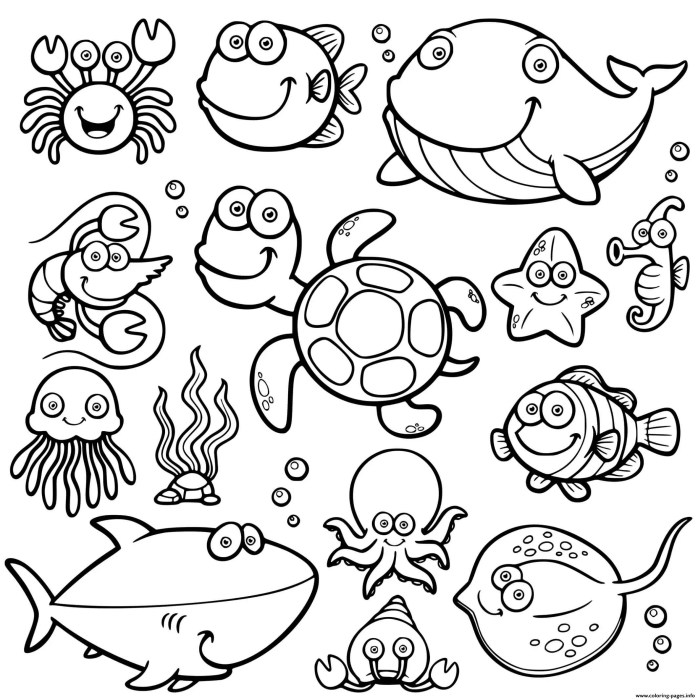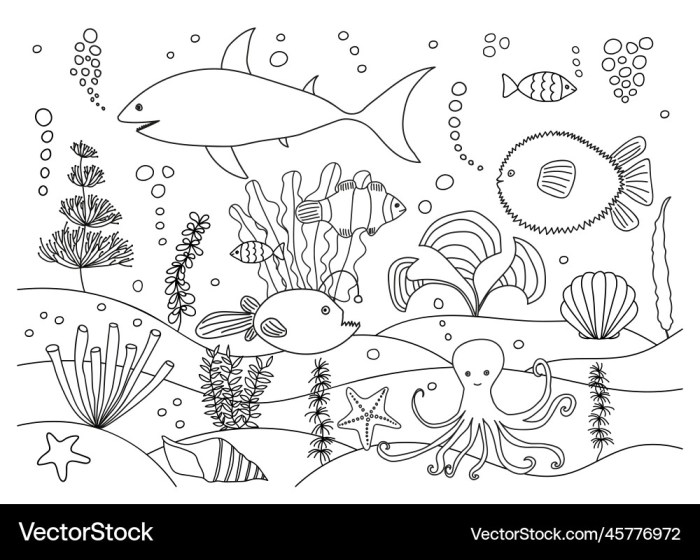Popular Sea Animal Coloring Page Subjects
Coloring page of sea animals – Coloring pages featuring sea animals offer a fun and educational way for children and adults to explore the wonders of the underwater world. These pages can spark creativity and an interest in marine life, encouraging further learning about these fascinating creatures.The visual appeal and unique characteristics of sea animals make them excellent subjects for coloring activities. Their diverse shapes, patterns, and vibrant colors provide ample opportunity for artistic expression.
Popular Sea Animal Choices
The following list highlights some of the most popular sea animal choices for coloring pages:
- Dolphins: Known for their intelligence and playful nature, dolphins have sleek, streamlined bodies perfect for dynamic poses in coloring pages.
- Sharks: The ocean’s apex predators, sharks have a powerful and intriguing presence, offering a range of coloring possibilities from the gentle whale shark to the more formidable great white.
- Whales: The largest animals on Earth, whales inspire awe with their immense size and gentle nature. Their massive forms and varied markings make them compelling coloring subjects.
- Turtles: With their patterned shells and slow, steady movements, sea turtles represent tranquility and resilience, offering intricate details for coloring enthusiasts.
- Starfish: These symmetrical invertebrates come in a variety of colors and patterns, providing a simple yet engaging subject for younger colorists.
- Jellyfish: Jellyfish, with their ethereal, translucent bodies and flowing tentacles, offer a unique and mesmerizing subject for coloring, allowing for creative use of color and shading.
- Seahorses: These delicate creatures, with their upright posture and curled tails, are a captivating subject, allowing for detailed coloring of their intricate bony plates.
- Clownfish: Made famous by the movie “Finding Nemo,” clownfish are instantly recognizable with their bright orange, white, and black stripes, providing a vibrant and cheerful coloring experience.
- Octopus: These intelligent invertebrates, with their eight arms and ability to change color, offer a complex and fascinating subject for coloring, allowing for exploration of texture and camouflage.
Popular Sea Animals for Coloring Pages: Descriptions
This table provides a brief overview of ten popular sea animals suitable for coloring pages:
| Sea Animal | Description | Sea Animal | Description |
|---|---|---|---|
| Dolphin | Highly intelligent marine mammals known for their playful behavior and streamlined bodies. | Shark | A diverse group of cartilaginous fish, ranging from the gentle whale shark to the powerful great white. |
| Whale | The largest animals on Earth, these majestic mammals inspire awe with their size and gentle nature. | Turtle | Reptiles with protective shells, known for their slow and steady movements in the ocean. |
| Starfish | Symmetrical invertebrates found in a variety of colors and patterns, often depicted in simple, child-friendly designs. | Jellyfish | Translucent, gelatinous creatures with flowing tentacles, offering a unique and mesmerizing coloring experience. |
| Seahorse | Delicate fish with an upright posture and curled tail, known for their intricate bony plates and unique appearance. | Clownfish | Brightly colored fish with orange, white, and black stripes, popularized by the movie “Finding Nemo.” |
| Octopus | Highly intelligent invertebrates with eight arms and the ability to change color and texture for camouflage. | Squid | Fast-swimming cephalopods with elongated bodies and ten arms, often depicted in dynamic poses. |
Creating Engaging Sea Animal Coloring Pages: Coloring Page Of Sea Animals

Creating captivating sea animal coloring pages involves thoughtful design and attention to detail. A well-designed coloring page can spark a child’s imagination, enhance their fine motor skills, and provide hours of creative fun. The following sections explore various techniques and styles to create appealing and engaging coloring pages featuring the wonders of the underwater world.
Tips for Designing Visually Appealing Sea Animal Coloring Pages, Coloring page of sea animals
Effective coloring pages balance intricate details with larger, simpler areas. This caters to different skill levels and prevents younger children from feeling overwhelmed. Varying line weights can add depth and visual interest. Thicker lines define the main Artikels of the sea creature, while thinner lines can be used for finer details like scales, fins, or patterns on the skin.
Leaving ample white space around the main subject ensures the creature stands out and provides space for children to add their own creative backgrounds.
The Process of Creating a Sea Animal Coloring Page
Creating a sea animal coloring page typically begins with a sketch. Initial sketches explore the pose and overall composition of the sea animal. Reference images are helpful during this stage to ensure anatomical accuracy or to capture the essence of a specific species. Once the sketch is finalized, the Artikels are refined and cleaned up. This often involves inking over the pencil lines with a pen or digitally tracing the sketch.
Finally, any unnecessary pencil lines are erased, leaving a clean line drawing ready to be colored.
Coloring pages of sea animals offer a fun and educational activity. For a wide variety of printable options, check out these sea animals coloring pages , featuring everything from playful dolphins to majestic whales. Such coloring pages allow children to explore the wonders of the ocean while developing their creativity.
Different Artistic Styles for Illustrating Sea Animals
Various artistic styles can be employed to create unique and engaging sea animal coloring pages. A realistic style focuses on accurate anatomical details and proportions, aiming for a lifelike representation of the sea creature. This style might feature detailed scales, realistic textures, and shading to create a sense of depth. A cartoonish style, on the other hand, simplifies the forms and exaggerates features for a more playful and whimsical effect.
Large eyes, expressive features, and simplified shapes are common characteristics of this style. An abstract style takes a more conceptual approach, focusing on shapes, colors, and patterns rather than strict realism. This style can be particularly engaging for older children who are interested in exploring different artistic interpretations. For example, a coloring page featuring an abstract seahorse could incorporate swirling lines, geometric shapes, and bold patterns, inviting children to experiment with color and create their own unique interpretations.
Showcasing Finished Artwork

Celebrating the completion of a sea animal coloring page enhances the creative experience and encourages further artistic exploration. Displaying and preserving these artworks allows children to take pride in their accomplishments and revisit their creations. Various methods can be employed to showcase these colorful masterpieces, from traditional displays to digital galleries.Preserving and displaying finished artwork fosters a sense of accomplishment and encourages continued creativity.
Several methods can be utilized to showcase these colorful creations.
Displaying Physical Artwork
Physical displays offer a tangible way to appreciate the artwork.
- Refrigerator Galleries: A classic and readily available option, using magnets to display artwork on the refrigerator allows for easy rotation and visibility.
- Framed Masterpieces: Framing elevates the artwork, giving it a more formal and cherished presentation. Simple, inexpensive frames can be used, or children can decorate the frames themselves for an added personal touch.
- Dedicated Art Walls: Designating a specific wall or section of a room as an “art gallery” provides a dedicated space to showcase artwork. This can be done using corkboards, string and clips, or even washi tape.
- Creating a Sea-Themed Display: Arrange the artwork to create an underwater scene. Adding blue background paper, paper seaweed, and other sea-themed decorations can enhance the display.
Encouraging Creativity and Personalization
Coloring pages can be a springboard for further creative expression.
- Adding Details and Backgrounds: Encourage children to extend the artwork beyond the lines of the sea animal. They can add backgrounds, such as coral reefs or ocean waves, and details like bubbles or other sea creatures.
- Mixed Media Exploration: Incorporate other art materials like glitter, stickers, or fabric scraps to add texture and dimension to the artwork.
- Storytelling Through Art: Prompt children to create stories about their colored sea animals. They can write or dictate their stories and display them alongside the artwork.
- Creating Themed Collections: Encourage children to color a series of sea animals, such as different types of fish, or creatures found in a specific ocean habitat. These collections can then be displayed together.
Creating a Digital Gallery
Digital galleries offer a convenient way to store, share, and preserve artwork.
- Scanning Artwork: Use a scanner or scanner app on a smartphone to create digital copies of the finished coloring pages.
- Organizing Digital Files: Create folders on a computer or in cloud storage to organize the digital artwork by theme, date, or artist.
- Creating Online Albums: Utilize free online photo sharing platforms to create digital albums of the artwork. These albums can be shared with family and friends.
- Making Digital Collages: Use photo editing software or apps to create digital collages of the artwork. These collages can be printed or used as digital wallpapers.
Accessibility and Variety in Sea Animal Coloring Pages
Offering a diverse selection of sea animal coloring pages ensures there’s something for everyone, regardless of their artistic skill or interest. Variety keeps coloring engaging and encourages exploration of different sea creatures and artistic styles. Accessibility in coloring pages means adapting designs to accommodate individuals with diverse needs and abilities, allowing everyone to participate in this creative activity.
Variety in Sea Animal Coloring Pages
Providing a range of complexity in coloring pages caters to different skill levels. Beginners can enjoy simpler designs with larger areas to color, while more experienced colorists can tackle intricate patterns and detailed illustrations. This variety also extends to the types of sea animals featured, appealing to a wider range of interests.
- Simple designs might feature a single, large seahorse with minimal detail.
- More complex designs could depict a coral reef scene teeming with various fish, corals, and other sea life.
Adapting Sea Animal Coloring Pages for Different Needs
Coloring pages can be adapted to suit individuals with various needs, ensuring inclusivity. These adaptations can enhance the coloring experience for those with motor skill challenges, visual impairments, or cognitive differences.
- For individuals with motor skill difficulties, providing coloring pages with thicker lines and larger spaces to color can be helpful. Simplified designs with fewer details are also beneficial.
- Those with visual impairments might benefit from coloring pages with high contrast between the lines and the background. Raised line coloring pages offer a tactile experience, allowing for tracing and coloring within defined areas.
- Coloring pages with simple instructions and clear visual cues can be helpful for individuals with cognitive differences. Focusing on single objects or scenes can reduce visual clutter and improve focus.
Examples of Simple and Complex Sea Animal Coloring Page Designs
The range of sea animal coloring pages can be illustrated with examples of varying complexity.
- Simple: A coloring page featuring a single, large starfish. The starfish has five rounded arms and a simple, happy face. The lines are thick and widely spaced, making it easy for younger children or those with motor skill challenges to color within the lines.
- Complex: A coloring page depicting a vibrant underwater scene. A detailed octopus sits on a coral reef, surrounded by smaller fish, sea anemones, and seaweed. The lines are thinner and closer together, offering a challenge for more experienced colorists. The various elements within the scene provide opportunities for intricate coloring and shading.
